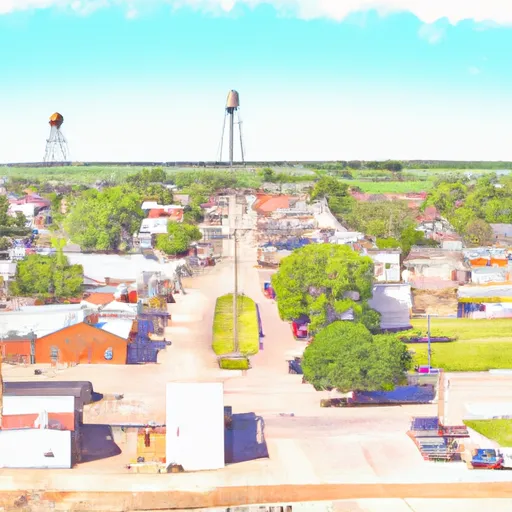-
 Snoflo Premium
Snoflo Premium
Get unlimited access to all our content
With no Ad interruptions! - Start Your Free Trial Login with existing account
Viola
Eden Index
Climate
8.3
•
Recreation
3.9
•
Community
•
Safeguard
4.7/10

Viola, Kansas is a small town located in the southern part of the state, known for its pleasant climate, hydrological features, and outdoor recreation opportunities. The town experiences a humid subtropical climate characterized by hot summers and mild winters. Summers are typically hot with temperatures averaging around 90°F (32°C), while winters are relatively mild with temperatures ranging from 20°F to 40°F (-7°C to 4°C). The area receives around 40 inches of rainfall annually, ensuring lush vegetation and plentiful water sources.
Viola is surrounded by natural beauty, with various rivers and lakes offering excellent hydrological constituents for outdoor enthusiasts. The nearby Arkansas River provides opportunities for fishing, boating, and kayaking. Cheney Reservoir, located just a short drive from Viola, is a popular spot for water sports, including swimming and water skiing. The region's numerous creeks and streams also attract hikers and nature enthusiasts looking to explore the scenic beauty of the area.
In addition to water activities, Viola offers ample opportunities for land-based outdoor recreation. The town is surrounded by rolling hills, making it ideal for hiking, camping, and wildlife viewing. The local parks and nature reserves provide well-maintained trails for hiking and biking, allowing visitors to immerse themselves in the peaceful natural surroundings.
Overall, Viola, Kansas offers a pleasant climate, abundant hydrological features, and diverse outdoor recreation opportunities, making it an attractive destination for nature lovers and adventure seekers.
What is the Eden Index?
The Snoflo Eden Index serves as a comprehensive rating system for regions, evaluating their desirability through a holistic assessment of climate health, outdoor recreation opportunities, and natural disaster risk, acknowledging the profound impact of these factors on livability and well-being.
Climate Health Indicator (CHI): 8.3
Viola receives approximately
817mm of rain per year,
with humidity levels near 83%
and air temperatures averaging around
14°C.
Viola has a plant hardyness factor of
6, meaning
plants and agriculture in this region thrive during a short period during spring and early summer. Most
plants will die off during the colder winter months.
By considering the ideal temperature range, reliable water supplies, clean air, and stable seasonal rain or snowpacks, the Climate Health Indicator (CHI) underscores the significance of a healthy climate as the foundation for quality living.
A healthy climate is paramount for ensuring a high quality of life and livability in a region, fostering both physical well-being and environmental harmony. This can be characterized by ideal temperatures, reliable access to water supplies, clean air, and consistent seasonal rain or snowpacks.
Weather Forecast
Streamflow Conditions
Middle Arkansas
Area Rivers
Middle Arkansas
Snowpack Depths
Middle Arkansas
Reservoir Storage Capacity
Middle Arkansas
Groundwater Levels
Recreational Opportunity Index (ROI): 3.9
The Recreational Opportunity Index (ROI) recognizes the value of outdoor recreational options, such as parks, hiking trails, camping sites, and fishing spots, while acknowledging that climate plays a pivotal role in ensuring the comfort and consistency of these experiences.
Access to outdoor recreational opportunities, encompassing activities such as parks, hiking, camping, and fishing, is crucial for overall well-being, and the climate plays a pivotal role in enabling and enhancing these experiences, ensuring that individuals can engage in nature-based activities comfortably and consistently.
Camping Areas
| Campground | Campsites | Reservations | Toilets | Showers | Elevation |
|---|---|---|---|---|---|
| Wellington Lake West Rec Area | None | 1,216 ft | |||
| Lake Afton Park | None | 1,381 ft | |||
| Argonia River Park | 14 | 1,223 ft | |||
| Wellington Lake East Rec Area | None | 1,225 ft |
Nearby Ski Areas
Catastrophe Safeguard Index (CSI):
The Catastrophe Safeguard Index (CSI) recognizes that natural disaster risk, encompassing floods, fires, hurricanes, and tornadoes, can drastically affect safety and the overall appeal of an area.
The level of natural disaster risk in a region significantly affects safety and the overall livability, with climate change amplifying these risks by potentially increasing the frequency and intensity of events like floods, fires, hurricanes, and tornadoes, thereby posing substantial challenges to community resilience and well-being.
Community Resilience Indicator (CRI):
The Community Resilience Indicator (CRI) recognizes that education, healthcare, and socioeconomics are crucial to the well-being of a region. The CRI acknowledges the profound impact of these elements on residents' overall quality of life. By evaluating educational resources, healthcare accessibility, and economic inclusivity, the index captures the essential aspects that contribute to a thriving community, fostering resident satisfaction, equity, and social cohesion.

